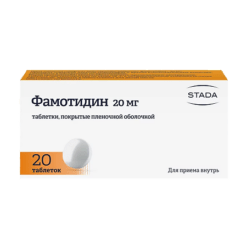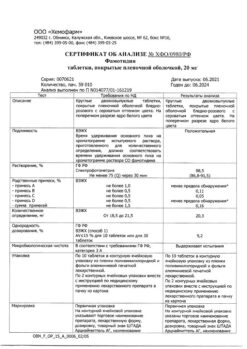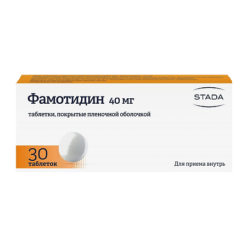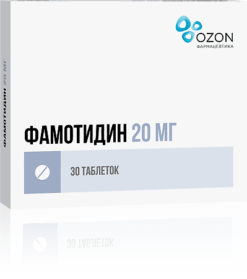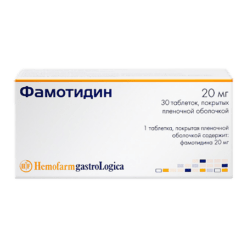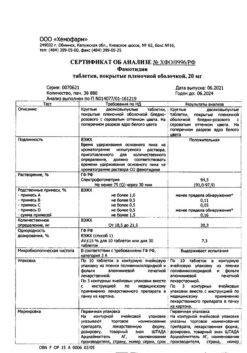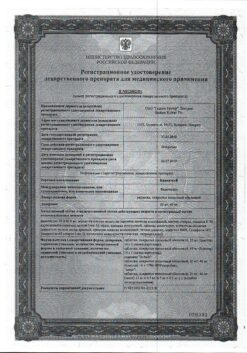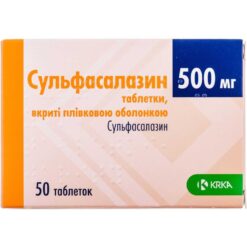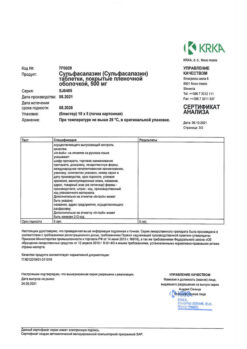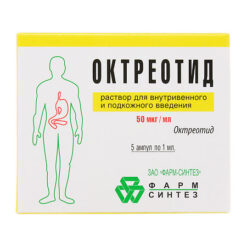No products in the cart.
Famotidine, 40 mg 20 pcs
€2.50 €2.08
EAN: 4607027764272
SKU: 229522
Categories: Medicine, Stomach, intestines, liver, Ulcer and gastritis
Description
Pharmacotherapeutic group
Gastric gland secretion reducing agent – H2-histamine receptor blocker
ATX code: A02BA03
Pharmacodynamics:
A 3rd generation H2-histamine receptor blocker. Suppresses basal and histamine-stimulated gastrin and acetylcholine production of hydrochloric acid. Reduces the activity of pepsin.
It enhances the protective mechanisms of the mucous membrane of the stomach by increasing the formation of gastric mucus increasing the content of glycoproteins in it stimulation of the secretion of hydrocarbonate endogenous synthesis of prostaglandins. Increases the regeneration rate of gastric mucosa and promotes healing of its damage (including cessation of gastrointestinal bleeding and scarring of stress ulcers). It does not significantly change the level of gastrin in plasma. It weakly inhibits cytochrome P450 oxidase system in the liver. After oral administration the action begins after 1 hour and reaches a maximum within 3 hours. The duration of action of the drug after a single dose depends on the dose and varies from 12 to 24 hours.
Pharmacokinetics:
After oral administration the drug is quickly absorbed from the gastrointestinal tract. After ingestion, the maximum plasma concentration is reached within 1-35 hours. Bioavailability is 40-45% increased with food and decreased with antacids. Binding to plasma proteins is 15-20%. 30-35% of famotidine is metabolized in the liver (with the formation of S-oxide). Elimination occurs mainly through the kidneys: 27-40% of the drug is excreted unchanged in the urine. The elimination half-life is 25-4 hours. Period of half-life increases up to 10-12 hours in patients with creatinine clearance less than 30 ml/min, up to 20 hours in patients with severe renal insufficiency (creatinine clearance less than 10 ml/min). It penetrates through the placental barrier and is excreted with breast milk.
Indications
Indications
Treatment and prevention of gastric and duodenal ulcers.
Treatment and prevention of symptomatic ulcers of the stomach and duodenum (associated with the use of non-steroidal anti-inflammatory drugs and stress postoperative ulcers).
Erosive gastroduodenitis.
Functional dyspepsia associated with increased secretory function of the stomach.
Reflux esophagitis.
Zollinger-Ellison syndrome.
Prevention of recurrent bleeding from the upper gastrointestinal tract. Prevention of aspiration of gastric juice during general anesthesia (Mendelssohn syndrome).
Pharmacological effect
Pharmacological effect
Pharmacotherapeutic group
gastric glands secretion reducer – H2-histamine receptor blocker
ATX code: A02BA03
Pharmacodynamics:
III generation H2-histamine receptor blocker. Suppresses basal and histamine-stimulated gastrin and acetylcholine production of hydrochloric acid. Reduces pepsin activity.
Strengthens the protective mechanisms of the gastric mucosa by increasing the formation of gastric mucus, increasing the content of glycoproteins in it, stimulating the secretion of bicarbonate and the endogenous synthesis of prostaglandins. Increases the rate of regeneration of the gastric mucosa and promotes the healing of its damage (including the cessation of gastrointestinal bleeding and scarring of stress ulcers). Does not significantly change plasma gastrin levels. Weakly suppresses the cytochrome P450 oxidase system in the liver. After oral administration, the effect begins within 1 hour and reaches a maximum within 3 hours. The duration of action of the drug after a single dose depends on the dose and ranges from 12 to 24 hours.
Pharmacokinetics:
After oral administration, the drug is quickly absorbed from the gastrointestinal tract. After administration, maximum plasma concentration is achieved within 1-35 hours. Bioavailability is 40-45%; it increases when taken with food and decreases when taking antacids. Communication with plasma proteins is 15-20%. 30-35% of famotidine is metabolized in the liver (to form S-oxide). Elimination mainly occurs through the kidneys: 27-40% of the drug is excreted unchanged in the urine. The half-life is 25-4 hours. In patients with creatinine clearance below 30 ml/min, the half-life increases to 10-12 hours; in patients with severe renal failure (creatinine clearance below 10 ml/min) – up to 20 hours. Penetrates the placental barrier and is excreted in breast milk.
Special instructions
Special instructions
Famotidine, like all H2-histamine blockers, should not be abruptly discontinued (rebound syndrome is typical).
Before starting treatment, it is necessary to exclude the possibility of a malignant neoplasm of the esophagus or duodenum.
With long-term treatment in weakened patients, bacterial damage to the stomach is possible with subsequent spread of infection.
Use with caution in patients with impaired liver function.
H2-histamine receptor blockers can counteract the effect of pentagastrin and histamine on the acid-forming function of the stomach; therefore, the use of H2-histamine receptor blockers is not recommended during the 24 hours preceding the test.
Histamine H2 receptor blockers may suppress the skin response to histamine, thus leading to false negative results (it is recommended that the use of histamine H2 receptor blockers be discontinued before performing diagnostic skin tests to detect an immediate allergic skin reaction).
During treatment, you should avoid consuming foods, drinks and medications that cause irritation of the gastric mucosa.
Active ingredient
Active ingredient
Famotidine
Composition
Composition
1 tablet contains:
active substance: famotidine 40 mg;
excipients: lactose (milk sugar), potato starch, low molecular weight povidone (low molecular weight medical polyvinylpyrrolidone), calcium stearate monohydrate (calcium stearic acid 1-water), stearic acid, hypromellose (hydroxypropyl methylcellulose), medium molecular weight povidone (medium molecular weight medical polyvinylpyrrolidone), titanium dioxide (titanium dioxide), polysorbate 80 (tween-80), tropeolin O.
Contraindications
Contraindications
Hypersensitivity to the components of the drug.
With caution:
Pregnancy, lactation, childhood, renal failure, liver failure, cirrhosis of the liver with a history of portosystemic encephalopathy.
Side Effects
Side Effects
From the digestive system: dry mouth, decreased appetite, nausea, vomiting, abdominal pain, increased activity of liver transaminases, constipation, diarrhea, jaundice, hepatocellular cholestatic or mixed hepatitis, acute pancreatitis.
From the hematopoietic organs: neutropenia, leukopenia, thrombocytopenia, hemolytic anemia, agranulocytosis, pancytopenia.
Allergic reactions: urticaria, skin rash, itching, bronchospasm, angioedema, erythema multiforme, exfoliative dermatitis, Stevens-Johnson syndrome, toxic epidermal necrolysis, anaphylactic shock.
From the cardiovascular system: decreased blood pressure, bradycardia, atrioventricular block, arrhythmia, vasculitis.
From the nervous system: headache asthenia drowsiness insomnia fatigue anxiety depression nervousness psychosis dizziness confusion hallucinations hyperthermia.
From the senses: ringing in the ears.
From the genitourinary system: with long-term use of large doses – decreased potency and libido.
From the musculoskeletal system: arthralgia, myalgia.
Other: dry skin, alopecia, gynecomastia.
Interaction
Interaction
Due to an increase in the pH of the gastric contents, concomitant use may decrease the absorption of ketoconazole.
When used simultaneously with antacids, sucralfate decreases the absorption rate of famotidine, so the interval between taking these drugs should be at least 1-2 hours.
Inhibits the metabolism in the liver of phenazone aminophenazone diazepam hexobarbital propranolol metoprolol lidocaine phenytoin theophylline indirect anticoagulants glipizide buformin metronidazole caffeine blockers of “slow” calcium channels. Increases the absorption of amoxicillin and clavulanic acid.
Bone marrow depressants increase the risk of developing neutropenia.
Overdose
Overdose
Symptoms: vomiting, motor agitation, tremor, decreased blood pressure, tachycardia, collapse.
Treatment: gastric lavage, symptomatic therapy, hemodialysis.
Storage conditions
Storage conditions
Store at a temperature not exceeding 25 °C.
Keep out of the reach of children.
Shelf life
Shelf life
3 years.
Do not use after the expiration date indicated on the package.
Manufacturer
Manufacturer
Ozon, Russia
Additional information
| Shelf life | 3 years. Do not use after the expiration date on the package. |
|---|---|
| Conditions of storage | Store at a temperature not exceeding 25 ° C. Store out of the reach of children. |
| Manufacturer | Ozon, Russia |
| Medication form | pills |
| Brand | Ozon |
Other forms…
Related products
Buy Famotidine, 40 mg 20 pcs with delivery to USA, UK, Europe and over 120 other countries.


